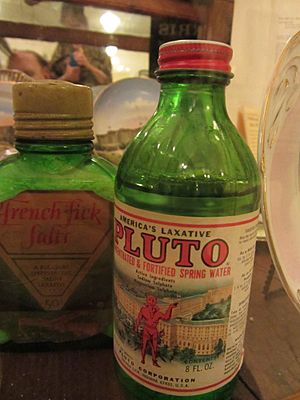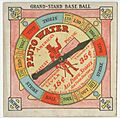Pluto Water facts for kids
Pluto Water was a popular brand of natural mineral water sold in the United States over 100 years ago. It was famous for being a strong laxative, which is a type of medicine that helps people who are having trouble going to the bathroom.
The water worked because it was full of natural mineral salts. Its main active ingredients were sodium sulfate and magnesium sulfate. These are natural minerals that help the body. The company that made Pluto Water said it usually worked within an hour. It was so popular that in 1919, it took 450 train cars to ship all the bottles being sold!
Where Did Pluto Water Come From?
Pluto Water came from natural mineral springs in a town called French Lick, Indiana. It was bottled at the famous French Lick Springs Hotel. This area was known for its special waters, and another brand called Sprudel Water also came from the same springs.
How Did It Work?
Pluto Water was known for working quickly. The company's ads said it could help you feel better in 30 minutes to two hours. This was because of the high amount of natural mineral salts in the water.
The main ingredients that made it work were sodium and magnesium sulfate. The water also had other minerals, including small amounts of lithium salts. In 1971, the government made new rules about using lithium in products. Because of these new rules, the company stopped selling Pluto Water.
Advertising and Slogans
Pluto Water was advertised as "America's Laxative." Its most famous slogan was, "When Nature Won't, PLUTO Will." This meant that if your body needed help, Pluto Water could do the job.
The bottles and ads often showed a picture of Pluto, the Roman god of the underworld. This was a clever way to show that the water came from deep underground springs.
Gallery
-
The famous escape artist Harry Houdini (left) stands near a Pluto Spring poster around 1907.
See also
- Lithia water










